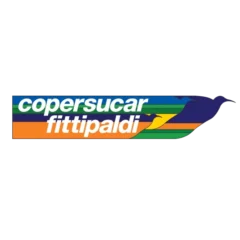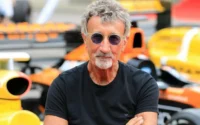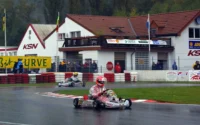Fittipaldi Automotive, often referred to as Copersucar after its initial major sponsor, was a Formula One racing team and constructor that competed from 1975 to 1982. It was the only Formula One team based in Brazil.
Notable Team Members and Drivers
Emerson Fittipaldi: A two-time Formula One World Champion, Emerson co-founded Fittipaldi Automotive with his brother Wilson. After leaving McLaren, he became the team’s main driver and later moved into a management role.
Keke Rosberg: The Finnish driver joined Fittipaldi Automotive from Wolf Racing and achieved a third-place finish in the 1980 season. Rosberg moved to Williams in 1982, which led to his World Championship.
Harvey Postlethwaite: A highly respected engineer, Postlethwaite joined Fittipaldi Automotive from Wolf Racing and led the design team in 1980. He developed the F7 and F8 cars and later moved to Ferrari.
The team was established in 1974 by racing driver Wilson Fittipaldi and his younger brother, double world champion Emerson Fittipaldi, with financial backing from the Brazilian sugar and alcohol cooperative Copersucar. The team raced under a Brazilian license.
Emerson Fittipaldi joined the team as a driver in 1976 after leaving McLaren but struggled to replicate his previous successes with the family-owned team. Future world champion Keke Rosberg achieved his first podium finish in Formula One with Fittipaldi Automotive.
Initially, the team was based in the Fittipaldis’ hometown of São Paulo, nearly 6,000 miles from the heart of the F1 HQ’s in the UK. In 1977, the team relocated to Reading, UK. Throughout its time on the grid in 119 Grand Prix between 1975 and 1982, Fittipaldi Automotive entered a total of 156 cars, achieved three podium finishes, and scored 44 championship points.
Copersucar-Fittipaldi (1975–1977)
The team, initially known as Copersucar-Fittipaldi, did not find great success in its debut season in 1975. In their first race, the 1975 Argentine Grand Prix, Wilson Fittipaldi crashed in chassis FD01 on lap 13, while his brother Emerson won the race in his McLaren. The subsequent chassis, FD02 and FD03, used for the rest of the year, shared the same design but significantly revised the original bodywork. Wilson was the only driver, managing just five finishes, with the highest being a 10th place at the 1975 US Grand Prix at Watkins Glen. He failed to qualify three times. Italian driver Arturo Merzario took over for the 1975 Italian Grand Prix after Wilson broke two bones in his hand during practice at the 1975 Austrian Grand Prix but did not fare any better.
Despite the lack of initial success, the team scored a significant coup for the following year: Emerson Fittipaldi left McLaren, where he had won his second Drivers’ Championship in 1974, to join his brother’s team. Wilson stepped down from driving to manage the team. Emerson acknowledged the challenges ahead, stating, “I am aware that I will virtually have no chance of winning the world title next season… It will be a very difficult beginning, but I am very enthusiastic and I am certain that with everybody’s effort we will have the first positive results in the second half of next year. I think that in the medium term of one or two years Brazil will have one of the best Formula One teams in the world.”
In 1976, Emerson was the team’s main driver, joined by Brazilian Ingo Hoffmann for four races. Emerson qualified the new FD04 in fifth place for its debut at Interlagos, but finished 13th due to engine problems, which was indicative of the season, during which he scored only three points. The qualifying result at Interlagos remained the best the team would ever achieve. Realising the logistical challenges of being based in Brazil, the team relocated to Reading, UK, where future cars would be built in the hub of “motorsport valley.”
The team maintained the same setup for 1977. Emerson managed to score several 4th and 5th places throughout the year. Hoffmann appeared in only the first two races, finishing 7th at the 1977 Brazilian Grand Prix. The new F5, which was painted yellow instead of silver (following the departure of technical director Divila, resulting in the ‘D’ being dropped from the designation), was introduced mid-season.
Fittipaldi Automotive (1978–1979)
While 1977 was not particularly successful, the 1978 season saw improvements with the F5A, which was modified to incorporate ground effect principles effectively demonstrated by Lotus. This allowed former World Champion Emerson Fittipaldi to achieve several strong results, including a competitive second place at the 1978 Brazilian Grand Prix after battling with Mario Andretti and Gilles Villeneuve. Fittipaldi finished the season with 17 points, and the team, now known as Fittipaldi Automotive, secured 7th place in the 1978 Constructors’ Championship, finishing ahead of Emerson’s former team, McLaren.
However, the promise shown in 1978 did not carry over into the 1979 season. Successfully implementing ground effect technology became essential for track success, but the understanding of this phenomenon was still developing. Ralph Bellamy’s design for the F6 proved to be ineffective on the track. Emerson Fittipaldi remained the team’s only driver, although Alex Ribeiro drove in the non-championship race inaugurating the Imola circuit that year. Ribeiro also attempted, but failed, to qualify for the season-ending North American championship races.
Skol Fittipaldi Team (1980)
At the end of 1979, Copersucar ended their sponsorship. The team acquired the remnants of their close neighbour, Wolf Racing, and became a two-car operation for the first time. Renamed Skol Team Fittipaldi for the 1980 season to reflect new sponsorship from Skol Brasil (now an AmBev brand), the team featured Emerson Fittipaldi and former Wolf Racing driver Keke Rosberg. They started the season with reworked Wolf chassis from the previous year, designated as F7s. These cars each brought a third-place finish for the drivers before being replaced by the less successful F8. The design team that year was headed by Harvey Postlethwaite, another asset from Wolf, and included a young chief aerodynamicist, Adrian Newey—both of whom would later design championship-winning cars for other teams.
Fittipaldi Automotive (1981–1982)
Emerson Fittipaldi decided to retire from racing at the end of 1980. Reflecting on his last two years in Formula One, he later said, “I was too involved in the problems of trying to make the team work, and I neglected my marriage and my personal life,” although he initially cited the deaths of his colleagues as his reason. Despite being only 33, he had spent a decade in Formula One. In his final season, he failed to finish seven of the last ten races and was often outpaced by his Finnish teammate, Keke Rosberg. After retiring, Emerson moved into the team’s management, and young Brazilian Chico Serra replaced him for the 1981 season.
With the loss of Skol sponsorship, the team reverted to the name Fittipaldi Automotive and began a sharp decline. Harvey Postlethwaite left for Ferrari early in the year, and the team raced updated variants of the previous season’s chassis, using tyres from Michelin, Avon, and Pirelli—even running different brands on their two cars at one race. Rosberg managed a fourth-place finish at the non-championship 1981 FOCA South African Grand Prix, but the rest of the season was marked by DNQs and retirements. When they did finish, it was usually at the back of the field, and they scored no points that year.
Rosberg moved to Williams in 1982, where he would go on to win the Drivers’ Championship. Fittipaldi Automotive continued with a single F8 for Serra, often using a chassis that had seen extensive use throughout the 1981 season. They managed to score a single point from a sixth-place finish at the 1982 Belgian Grand Prix at Zolder after Niki Lauda was disqualified. A final new car, the F9, was designed by the returning Divila and Tim Wright and introduced at the British Grand Prix, but it failed to improve the team’s performance. The Fittipaldi brothers attempted to raise funds to continue in 1983, but the team ultimately closed its doors early that year.
Fittipaldi Automotive Formula One World Championship Records
| First entry | 1975 Argentine Grand Prix |
|---|---|
| Races entered | 120 (103 starts) |
| Engines | Ford |
| Constructors’ Championships | 0 |
| Drivers’ Championships | 0 |
| Race victories | 0 |
| Podiums | 3 |
| Points | 44 |
| Pole positions | 0 |
| Fastest laps | 0 |
| Final entry | 1982 Caesars Palace Grand Prix |
Entrant Names
| Years | Name |
|---|---|
| 1975–1976 | Copersucar-Fittipaldi |
| 1980 | Skol Fittipaldi Team |
| 1977–1979, 1981–1982 | Fittipaldi Automotive |
Fittipaldi Automotive Constructors’ Championship Results
| Year | Chassis | Engine | Tyre | No. | Drivers | Rounds | WCC Points | WCC Pos. |
|---|---|---|---|---|---|---|---|---|
| 1975 | FD01 FD02 FD03 | Ford Cosworth DFV V8 3.0 | G | 30 | Wilson Fittipaldi Júnior | 1–12, 14 | 0 | NC |
| Arturo Merzario | 13 | |||||||
| 1976 | FD03 FD04 | Ford Cosworth DFV V8 3.0 | G | 30 | Emerson Fittipaldi | All | 3 | 11th |
| 31 | Ingo Hoffmann | 1, 3–4, 8 | ||||||
| 1977 | FD04 F5 | Ford Cosworth DFV V8 3.0 | G | 28 | Emerson Fittipaldi | 1–16 | 11 | 9th |
| 29 | Ingo Hoffmann | 1–2 | ||||||
| 1978 | F5A | Ford Cosworth DFV V8 3.0 | G | 14 | Emerson Fittipaldi | All | 17 | 7th |
| 1979 | F5A F6A | Ford Cosworth DFV V8 3.0 | G | 14 | Emerson Fittipaldi | All | 1 | 12th |
| 19 | Alex Ribeiro | 14–15 | ||||||
| 1980 | F7 F8 | Ford Cosworth DFV V8 3.0 | G | 20 | Emerson Fittipaldi | All | 11 | 9th |
| 21 | Keke Rosberg | All | ||||||
| 1981 | F8C | Ford Cosworth DFV V8 3.0 | A M P | 20 | Keke Rosberg | 1–10, 12–15 | 0 | NC |
| 21 | Chico Serra | 1–10, 12–15 | ||||||
| 1982 | F8C F9 | Ford Cosworth DFV V8 3.0 | P | 14 | Chico Serra | 1–3, 5–16 | 1 | 14th |
Source: Wikipedia.com and fandom.com



